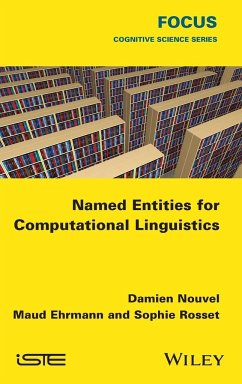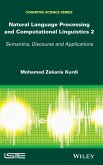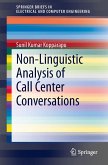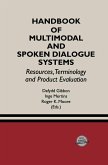- Gebundenes Buch
- Merkliste
- Auf die Merkliste
- Bewerten Bewerten
- Teilen
- Produkt teilen
- Produkterinnerung
- Produkterinnerung
One of the challenges brought on by the digital revolution of the recent decades is the mechanism by which information carried by texts can be extracted in order to access its contents. The processing of named entities remains a very active area of research, which plays a central role in natural language processing technologies and their applications. Named entity recognition, a tool used in information extraction tasks, focuses on recognizing small pieces of information in order to extract information on a larger scale. The authors use written text and examples in French and English to…mehr
Andere Kunden interessierten sich auch für
![Natural Language Processing and Computational Linguistics 2 Natural Language Processing and Computational Linguistics 2]() Mohamed Zakaria KurdiNatural Language Processing and Computational Linguistics 2187,99 €
Mohamed Zakaria KurdiNatural Language Processing and Computational Linguistics 2187,99 €![Non-Linguistic Analysis of Call Center Conversations Non-Linguistic Analysis of Call Center Conversations]() Sunil Kumar KopparapuNon-Linguistic Analysis of Call Center Conversations38,99 €
Sunil Kumar KopparapuNon-Linguistic Analysis of Call Center Conversations38,99 €![Dictionary of Electrical Engineering Dictionary of Electrical Engineering]() LuginskyDictionary of Electrical Engineering149,99 €
LuginskyDictionary of Electrical Engineering149,99 €![Global Digital Transformation and the Covid-19 Pandemic Global Digital Transformation and the Covid-19 Pandemic]() Global Digital Transformation and the Covid-19 Pandemic197,99 €
Global Digital Transformation and the Covid-19 Pandemic197,99 €![Dictionary of Electrical Engineering Dictionary of Electrical Engineering]() Dictionary of Electrical Engineering161,99 €
Dictionary of Electrical Engineering161,99 €![Handbook of Multimodal and Spoken Dialogue Systems Handbook of Multimodal and Spoken Dialogue Systems]() Dafydd Gibbon / Inge Mertins / Roger K. Moore (Hgg.)Handbook of Multimodal and Spoken Dialogue Systems240,99 €
Dafydd Gibbon / Inge Mertins / Roger K. Moore (Hgg.)Handbook of Multimodal and Spoken Dialogue Systems240,99 €![Computational Electromagnetic-Aerodynamics Computational Electromagnetic-Aerodynamics]() Joseph J S ShangComputational Electromagnetic-Aerodynamics158,99 €
Joseph J S ShangComputational Electromagnetic-Aerodynamics158,99 €-
-
-
One of the challenges brought on by the digital revolution of the recent decades is the mechanism by which information carried by texts can be extracted in order to access its contents. The processing of named entities remains a very active area of research, which plays a central role in natural language processing technologies and their applications. Named entity recognition, a tool used in information extraction tasks, focuses on recognizing small pieces of information in order to extract information on a larger scale. The authors use written text and examples in French and English to present the necessary elements for the readers to familiarize themselves with the main concepts related to named entities and to discover the problems associated with them, as well as the methods available in practice for solving these issues.--
Hinweis: Dieser Artikel kann nur an eine deutsche Lieferadresse ausgeliefert werden.
Hinweis: Dieser Artikel kann nur an eine deutsche Lieferadresse ausgeliefert werden.
Produktdetails
- Produktdetails
- Verlag: Wiley
- Seitenzahl: 192
- Erscheinungstermin: 8. Februar 2016
- Englisch
- Abmessung: 240mm x 161mm x 15mm
- Gewicht: 451g
- ISBN-13: 9781848218383
- ISBN-10: 1848218389
- Artikelnr.: 42911611
- Herstellerkennzeichnung
- Libri GmbH
- Europaallee 1
- 36244 Bad Hersfeld
- gpsr@libri.de
- Verlag: Wiley
- Seitenzahl: 192
- Erscheinungstermin: 8. Februar 2016
- Englisch
- Abmessung: 240mm x 161mm x 15mm
- Gewicht: 451g
- ISBN-13: 9781848218383
- ISBN-10: 1848218389
- Artikelnr.: 42911611
- Herstellerkennzeichnung
- Libri GmbH
- Europaallee 1
- 36244 Bad Hersfeld
- gpsr@libri.de
Damien Nouvel is Associate Professor at the National Institute of Oriental Languages And Civilizations (Inalto) in Paris, France. Maud Ehrmann is a Research Scientist at EPFL (École polytechnique fédérale de Lausanne) in Geneva, Switzerland. Sophie Rosset is a Senior Researcher at the French National Centre for Scientific Research (CNRS) in Paris, France.
Introduction ix
Chapter 1. Named Entities for Accessing Information 1
1.1. Research program history 2
1.1.1. Understanding documents: an ambitious task 2
1.1.2. Detecting basic elements: named entities 3
1.1.3. Trend: a return to slot filling 7
1.2. Task using named entities as a basic representation 9
1.3. Conclusion 10
Chapter 2. Named Entities, Referential Units 11
2.1. Issues with the named entity concept 12
2.1.1. A heterogeneous set 12
2.1.2. Existing defining formulas 17
2.1.3. An NLP object 21
2.2. The notions of meaning and reference 22
2.2.1. What is the reference? 22
2.2.2. What is meaning? 24
2.3. Proper names 27
2.3.1. The traditional criteria for defining a proper name 28
2.3.2. Meaning and referential function of proper names 30
2.3.3. The "referential load" of proper names 34
2.4. Definite descriptions 35
2.4.1. What is a definite description? 35
2.4.2. The meaning of definite descriptions 38
2.4.3. Complete and incomplete definite descriptions 39
2.5. The meaning and referential functioning of named entities 41
2.5.1. Reference to a particular 42
2.5.2. Referential autonomy 44
2.5.3. A "natural" heterogeneity 45
2.6. Conclusion 46
Chapter 3. Resources Associated with Named Entities 47
3.1. Typologies: general and specialist domains 48
3.1.1. The notion of category 48
3.1.2. Typology development 49
3.1.3. Typologies beyond evaluation campaigns 53
3.1.4. Other uses of typologies 54
3.1.5. Illustrated comparison 57
3.1.6. Issues to consider regarding entities 57
3.2. Corpora 59
3.2.1. Introduction . 59
3.2.2. Corpora and named entities 60
3.2.3. Conclusion 65
3.3. Lexicons and knowledge databases 65
3.3.1. Lexical databases 66
3.3.2. Knowledge databases 72
3.4. Conclusion 75
Chapter 4. Recognizing Named Entities 77
4.1. Detection and classification of named entities 78
4.2. Indicators for named entity recognition 79
4.2.1. Describing word morphology 79
4.2.2. Using lexical databases 81
4.2.3. Contextual clues 83
4.2.4. Conclusion 85
4.3. Rule-based techniques 85
4.4. Data-driven and machine-learning systems 88
4.4.1. Majority class models 91
4.4.2. Contextual models (HMM) 92
4.4.3. Multiple feature models (Softmax and MaxEnt) 93
4.4.4. Conditional Random Fields (CRFs) 95
4.5. Unsupervised enrichment of supervised methods 95
4.6. Conclusion 96
Chapter 5. Linking Named Entities to References 99
5.1. Knowledge bases 100
5.2. Formalizing polysemy in named entity mentions 102
5.3. Stages in the named entity linking process 103
5.3.1. Detecting mentions of named entities 103
5.3.2. Selecting candidates for each mention 103
5.3.3. Entity disambiguation 104
5.3.4. Entity linking 106
5.4. System performance 106
5.4.1. Practical application: DBpedia Spotlight 107
5.4.2. Future prospects 108
Chapter 6. Evaluating Named Entity Recognition 111
6.1. Classic measurements: precision, recall and F-measures 112
6.2. Measures using error counts 115
6.3. Evaluating associated tasks 120
6.3.1. Detecting entities and mentions 121
6.3.2. Entity detection and linking 122
6.4. Evaluating preprocessing technologies 126
6.5. Conclusion 128
Conclusion 131
Appendices 137
Appendix 1. Glossary 139
Appendix 2. Named Entities: Research Programs 141
Appendix 3. Summary of Available Corpora 147
Appendix 4. Annotation Formats 151
Appendix 5. Named Entities: Current Definitions 153
Bibliography 157
Index 169
Chapter 1. Named Entities for Accessing Information 1
1.1. Research program history 2
1.1.1. Understanding documents: an ambitious task 2
1.1.2. Detecting basic elements: named entities 3
1.1.3. Trend: a return to slot filling 7
1.2. Task using named entities as a basic representation 9
1.3. Conclusion 10
Chapter 2. Named Entities, Referential Units 11
2.1. Issues with the named entity concept 12
2.1.1. A heterogeneous set 12
2.1.2. Existing defining formulas 17
2.1.3. An NLP object 21
2.2. The notions of meaning and reference 22
2.2.1. What is the reference? 22
2.2.2. What is meaning? 24
2.3. Proper names 27
2.3.1. The traditional criteria for defining a proper name 28
2.3.2. Meaning and referential function of proper names 30
2.3.3. The "referential load" of proper names 34
2.4. Definite descriptions 35
2.4.1. What is a definite description? 35
2.4.2. The meaning of definite descriptions 38
2.4.3. Complete and incomplete definite descriptions 39
2.5. The meaning and referential functioning of named entities 41
2.5.1. Reference to a particular 42
2.5.2. Referential autonomy 44
2.5.3. A "natural" heterogeneity 45
2.6. Conclusion 46
Chapter 3. Resources Associated with Named Entities 47
3.1. Typologies: general and specialist domains 48
3.1.1. The notion of category 48
3.1.2. Typology development 49
3.1.3. Typologies beyond evaluation campaigns 53
3.1.4. Other uses of typologies 54
3.1.5. Illustrated comparison 57
3.1.6. Issues to consider regarding entities 57
3.2. Corpora 59
3.2.1. Introduction . 59
3.2.2. Corpora and named entities 60
3.2.3. Conclusion 65
3.3. Lexicons and knowledge databases 65
3.3.1. Lexical databases 66
3.3.2. Knowledge databases 72
3.4. Conclusion 75
Chapter 4. Recognizing Named Entities 77
4.1. Detection and classification of named entities 78
4.2. Indicators for named entity recognition 79
4.2.1. Describing word morphology 79
4.2.2. Using lexical databases 81
4.2.3. Contextual clues 83
4.2.4. Conclusion 85
4.3. Rule-based techniques 85
4.4. Data-driven and machine-learning systems 88
4.4.1. Majority class models 91
4.4.2. Contextual models (HMM) 92
4.4.3. Multiple feature models (Softmax and MaxEnt) 93
4.4.4. Conditional Random Fields (CRFs) 95
4.5. Unsupervised enrichment of supervised methods 95
4.6. Conclusion 96
Chapter 5. Linking Named Entities to References 99
5.1. Knowledge bases 100
5.2. Formalizing polysemy in named entity mentions 102
5.3. Stages in the named entity linking process 103
5.3.1. Detecting mentions of named entities 103
5.3.2. Selecting candidates for each mention 103
5.3.3. Entity disambiguation 104
5.3.4. Entity linking 106
5.4. System performance 106
5.4.1. Practical application: DBpedia Spotlight 107
5.4.2. Future prospects 108
Chapter 6. Evaluating Named Entity Recognition 111
6.1. Classic measurements: precision, recall and F-measures 112
6.2. Measures using error counts 115
6.3. Evaluating associated tasks 120
6.3.1. Detecting entities and mentions 121
6.3.2. Entity detection and linking 122
6.4. Evaluating preprocessing technologies 126
6.5. Conclusion 128
Conclusion 131
Appendices 137
Appendix 1. Glossary 139
Appendix 2. Named Entities: Research Programs 141
Appendix 3. Summary of Available Corpora 147
Appendix 4. Annotation Formats 151
Appendix 5. Named Entities: Current Definitions 153
Bibliography 157
Index 169
Introduction ix
Chapter 1. Named Entities for Accessing Information 1
1.1. Research program history 2
1.1.1. Understanding documents: an ambitious task 2
1.1.2. Detecting basic elements: named entities 3
1.1.3. Trend: a return to slot filling 7
1.2. Task using named entities as a basic representation 9
1.3. Conclusion 10
Chapter 2. Named Entities, Referential Units 11
2.1. Issues with the named entity concept 12
2.1.1. A heterogeneous set 12
2.1.2. Existing defining formulas 17
2.1.3. An NLP object 21
2.2. The notions of meaning and reference 22
2.2.1. What is the reference? 22
2.2.2. What is meaning? 24
2.3. Proper names 27
2.3.1. The traditional criteria for defining a proper name 28
2.3.2. Meaning and referential function of proper names 30
2.3.3. The "referential load" of proper names 34
2.4. Definite descriptions 35
2.4.1. What is a definite description? 35
2.4.2. The meaning of definite descriptions 38
2.4.3. Complete and incomplete definite descriptions 39
2.5. The meaning and referential functioning of named entities 41
2.5.1. Reference to a particular 42
2.5.2. Referential autonomy 44
2.5.3. A "natural" heterogeneity 45
2.6. Conclusion 46
Chapter 3. Resources Associated with Named Entities 47
3.1. Typologies: general and specialist domains 48
3.1.1. The notion of category 48
3.1.2. Typology development 49
3.1.3. Typologies beyond evaluation campaigns 53
3.1.4. Other uses of typologies 54
3.1.5. Illustrated comparison 57
3.1.6. Issues to consider regarding entities 57
3.2. Corpora 59
3.2.1. Introduction . 59
3.2.2. Corpora and named entities 60
3.2.3. Conclusion 65
3.3. Lexicons and knowledge databases 65
3.3.1. Lexical databases 66
3.3.2. Knowledge databases 72
3.4. Conclusion 75
Chapter 4. Recognizing Named Entities 77
4.1. Detection and classification of named entities 78
4.2. Indicators for named entity recognition 79
4.2.1. Describing word morphology 79
4.2.2. Using lexical databases 81
4.2.3. Contextual clues 83
4.2.4. Conclusion 85
4.3. Rule-based techniques 85
4.4. Data-driven and machine-learning systems 88
4.4.1. Majority class models 91
4.4.2. Contextual models (HMM) 92
4.4.3. Multiple feature models (Softmax and MaxEnt) 93
4.4.4. Conditional Random Fields (CRFs) 95
4.5. Unsupervised enrichment of supervised methods 95
4.6. Conclusion 96
Chapter 5. Linking Named Entities to References 99
5.1. Knowledge bases 100
5.2. Formalizing polysemy in named entity mentions 102
5.3. Stages in the named entity linking process 103
5.3.1. Detecting mentions of named entities 103
5.3.2. Selecting candidates for each mention 103
5.3.3. Entity disambiguation 104
5.3.4. Entity linking 106
5.4. System performance 106
5.4.1. Practical application: DBpedia Spotlight 107
5.4.2. Future prospects 108
Chapter 6. Evaluating Named Entity Recognition 111
6.1. Classic measurements: precision, recall and F-measures 112
6.2. Measures using error counts 115
6.3. Evaluating associated tasks 120
6.3.1. Detecting entities and mentions 121
6.3.2. Entity detection and linking 122
6.4. Evaluating preprocessing technologies 126
6.5. Conclusion 128
Conclusion 131
Appendices 137
Appendix 1. Glossary 139
Appendix 2. Named Entities: Research Programs 141
Appendix 3. Summary of Available Corpora 147
Appendix 4. Annotation Formats 151
Appendix 5. Named Entities: Current Definitions 153
Bibliography 157
Index 169
Chapter 1. Named Entities for Accessing Information 1
1.1. Research program history 2
1.1.1. Understanding documents: an ambitious task 2
1.1.2. Detecting basic elements: named entities 3
1.1.3. Trend: a return to slot filling 7
1.2. Task using named entities as a basic representation 9
1.3. Conclusion 10
Chapter 2. Named Entities, Referential Units 11
2.1. Issues with the named entity concept 12
2.1.1. A heterogeneous set 12
2.1.2. Existing defining formulas 17
2.1.3. An NLP object 21
2.2. The notions of meaning and reference 22
2.2.1. What is the reference? 22
2.2.2. What is meaning? 24
2.3. Proper names 27
2.3.1. The traditional criteria for defining a proper name 28
2.3.2. Meaning and referential function of proper names 30
2.3.3. The "referential load" of proper names 34
2.4. Definite descriptions 35
2.4.1. What is a definite description? 35
2.4.2. The meaning of definite descriptions 38
2.4.3. Complete and incomplete definite descriptions 39
2.5. The meaning and referential functioning of named entities 41
2.5.1. Reference to a particular 42
2.5.2. Referential autonomy 44
2.5.3. A "natural" heterogeneity 45
2.6. Conclusion 46
Chapter 3. Resources Associated with Named Entities 47
3.1. Typologies: general and specialist domains 48
3.1.1. The notion of category 48
3.1.2. Typology development 49
3.1.3. Typologies beyond evaluation campaigns 53
3.1.4. Other uses of typologies 54
3.1.5. Illustrated comparison 57
3.1.6. Issues to consider regarding entities 57
3.2. Corpora 59
3.2.1. Introduction . 59
3.2.2. Corpora and named entities 60
3.2.3. Conclusion 65
3.3. Lexicons and knowledge databases 65
3.3.1. Lexical databases 66
3.3.2. Knowledge databases 72
3.4. Conclusion 75
Chapter 4. Recognizing Named Entities 77
4.1. Detection and classification of named entities 78
4.2. Indicators for named entity recognition 79
4.2.1. Describing word morphology 79
4.2.2. Using lexical databases 81
4.2.3. Contextual clues 83
4.2.4. Conclusion 85
4.3. Rule-based techniques 85
4.4. Data-driven and machine-learning systems 88
4.4.1. Majority class models 91
4.4.2. Contextual models (HMM) 92
4.4.3. Multiple feature models (Softmax and MaxEnt) 93
4.4.4. Conditional Random Fields (CRFs) 95
4.5. Unsupervised enrichment of supervised methods 95
4.6. Conclusion 96
Chapter 5. Linking Named Entities to References 99
5.1. Knowledge bases 100
5.2. Formalizing polysemy in named entity mentions 102
5.3. Stages in the named entity linking process 103
5.3.1. Detecting mentions of named entities 103
5.3.2. Selecting candidates for each mention 103
5.3.3. Entity disambiguation 104
5.3.4. Entity linking 106
5.4. System performance 106
5.4.1. Practical application: DBpedia Spotlight 107
5.4.2. Future prospects 108
Chapter 6. Evaluating Named Entity Recognition 111
6.1. Classic measurements: precision, recall and F-measures 112
6.2. Measures using error counts 115
6.3. Evaluating associated tasks 120
6.3.1. Detecting entities and mentions 121
6.3.2. Entity detection and linking 122
6.4. Evaluating preprocessing technologies 126
6.5. Conclusion 128
Conclusion 131
Appendices 137
Appendix 1. Glossary 139
Appendix 2. Named Entities: Research Programs 141
Appendix 3. Summary of Available Corpora 147
Appendix 4. Annotation Formats 151
Appendix 5. Named Entities: Current Definitions 153
Bibliography 157
Index 169








